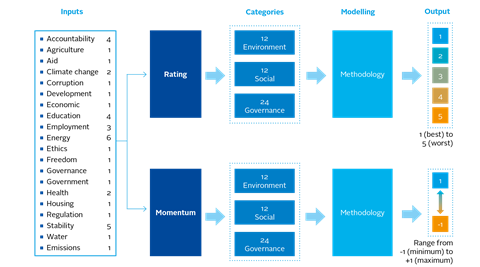Case study by Insight Investment
| Author | Joshua Kendall, Senior ESG Analyst |
|---|---|
|
Market participant |
Asset Manager |
|
Total AUM |
US$790 billion (as at September 2018)36 |
|
FI AUM |
US$166 billion (as at September 2018) |
|
Operating country |
Global |
Action areas:
- Materiality of ESG factors
- Organisational approach
- Transparency and communication
The investment approach
Insight believes that investing effectively in sovereign debt requires in-depth analysis of ESG matters. However, most ESG analysis and research focuses on corporates – not countries. As a result, awareness of the materiality of risks, and the availability of tools to help make informed decisions, are lacking for sovereign debt investors, especially in emerging markets.
We set out to build a ratings model that complemented our existing country valuation and risk models. To ensure the relevance of our ratings for our FI strategies, we aimed to focus on metrics from credible sources that also have the potential to be material to country risks.
The investment process
We built a proprietary model to help us better understand ESG risks at the country level across our portfolios. Insight’s country sustainability risk model generates two complementary ratings to give our portfolio managers greater insight over long-term trends:
- The model’s overall ESG rating offers a snapshot of a country’s current standing regarding ESG factors, based on the latest available data.
- Meanwhile, the model’s ESG momentum score, which illustrates a country’s improvement or deterioration with regard to ESG factors over a six-year period, can be used to identify longer-term trends, which may develop into material risks.
Not all data sets include metrics for every country. In total, the model scores 186 countries. We have excluded 31 countries (which have very limited debt issuance) in the final output due to insufficient data across the underlying data sets.
Finally, the ESG scores are combined to create an overall ESG rating, of which the environmental and social scores account for 30 percent, with governance scores accounting for 40 percent. This reflects the tendency for governance issues to have a greater short-term impact on a country’s creditworthiness, and the larger number of governance metrics within the model (see below).

The investment outcomes
Results from the model provide a starting point for further analysis. Initial insights include:
- Countries with higher GDP per capita typically have better ESG ratings. This is generally driven by governance and social factors, not environmental scores.
- More countries are deteriorating on ESG than improving, with the majority of developed markets receiving a negative ESG momentum score.
- ESG momentum has a weak relationship overall with standard industry measures of sovereign credit risk, but there are outliers.
Below are some of the data highlights of the analysis (see below):


Key takeaways
We integrate the model scores within our research, which supports our investment decision making. We use it to:
- Expand the scope of our existing risk models: when making investment decisions regarding sovereign debt, and other related debt such as issues from state-owned enterprises where the sovereign is effectively the backing entity, identifying changes in economic conditions and the risk profile of the relevant country are key. ESG indicators can provide another angle. Our country sustainability model supplies two further inputs to the FI group’s wider models, providing more in-depth information on their investment universe.
- Manage client-specific portfolios with ESG guidelines: we manage strategies for clients that specify that the overall ESG rating of portfolio holdings must exceed that of the relevant benchmark. The model enables us to exclude or include issuers based on their ESG performance.
- Support reporting to clients on ESG-specific factors: the model’s ratings demonstrate how sovereign debt portfolios perform from an ESG perspective, on an absolute basis or relative to a benchmark.
- Indicate issues for dialogue: dialogue with sovereign issuers can be challenging and politically sensitive, but there can be opportunities to start discussions with officials from relevant agencies. Our model presents a tool by which we might identify and prioritise matters to address with sovereign issuers. This is particularly relevant to emerging markets.
Download the report
-

Shifting perceptions: ESG, credit risk and ratings: part 3 - from disconnects to action areas
January 2019
ESG, credit risk and ratings: part 3 - from disconnects to action areas
- 1
- 2
- 3
- 4
- 5
- 6
- 7
- 8
- 9
- 10
- 11
- 12
- 13
- 14
- 15
- 16
- 17
- 18
- 19
- 20
- 21
- 22
- 23
 Currently reading
Currently readingCase study: Insight Investment
- 24
- 25


































